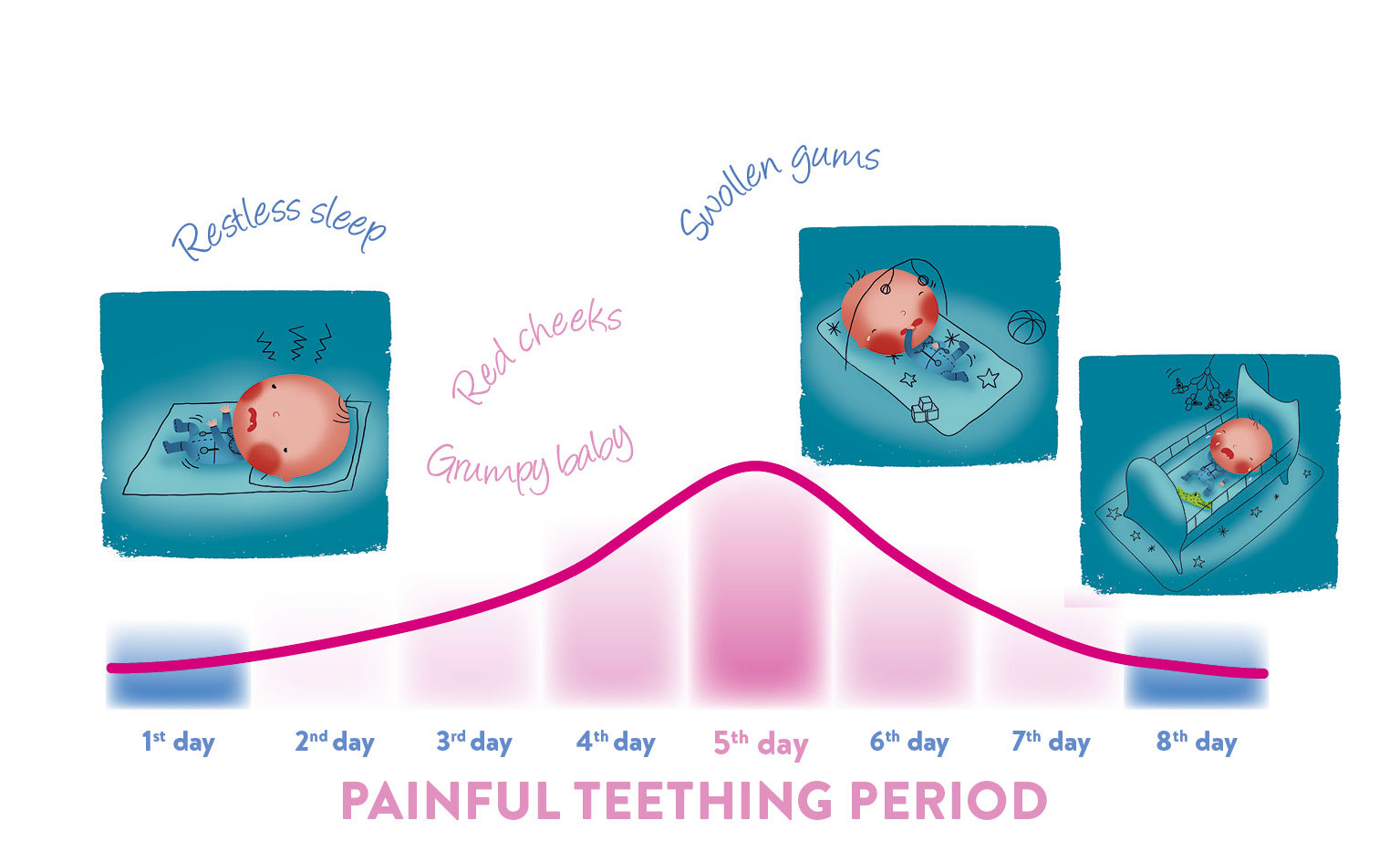Parent's guide - BABY TEETHING
What is a teething?
Teething occurs when baby teeth start to come out of the gum and settle in the baby's mouth. It is a natural phenomenon that follows a variable calendar from one child to another. In some babies, it goes unnoticed, while for others it is accompanied by discomfort. Gum pain, accessive salivation, swollen gums, red cheeks, the desire to chew everything, grumpy behavior, restless sleep, fever not exceeding 38 ° ... these are signs of the appearance of a tooth.

The first teething occurs most often around 6 months and the baby teeth are all in place before the child is 3 years old. The baby's teeth then include 20 teeth, or 10 per arch.
Incisors: 8 incisor teeth are located in the front part of mouth. Four of them are in the upper jaw and four in the lower jaw. Incisors are shaped like small chisels. They have sharp edges that help you bite into food. Whenever you sink your teeth into something, such as an apple, you use your incisor teeth. First comes a central incisor of the lower jaw, then the 3 other central incisors.
Canines: 4 canine teeth sit next to the incisors. You have two canines on the top of the mouth and two on the bottom. Canines have a sharp, pointy surface for tearing food. The first baby canines come in between the ages of 16 months and 20 months. The upper canines grow in first, followed by the lower canines.
Morlars: Molars are biggest and strongest teeth. There are six on the top (first molars) and six on the bottom (second molars). The large surface area of molars helps them grind up food. When baby eats, his tongue pushes food to the back of his mouth. Then, molars break up the food into pieces small enough for him to swallow. The molars include four wisdom teeth, which are the last set of teeth to come in. They usually come in between the ages of 17 and 25. Wisdom teeth are also called third molars.
From 6 years onwards, milk teeth fall out and the permanent teeth become established. At around 12 years of age, the child will have 28 teeth, and 32 teeth at around 18 years of age, with the eventual growth of the wisdom.

Teething pains
The signs of teething vary from child to child. Even if it causes inconvenience, it does not necessarily make the child sick. Teething symptoms are more frequent in the 4 days before a tooth emergence, the day of the emergence, and 3 days after it, so this 8-day window was defined as the teething period.
Signs of teething:
- Painful, swollen gums
- Irritability, restlessness
- Fever not exceeding 38 ° c
- Lack of appetite
- Disturbed sleep, difficulty falling asleep
- Red cheeks
- Nibbles
- Tendency to put fingers or objects in his mouth
- Accesive salivation
DID YOU KNOW ?
Generally, teething does not cause a temperature above 38 ° C or a deterioration of the general condition.
Tips to relieve baby teething
- Comfort the baby
- Rub your gums gently with a perfectly washed finger or with a clean, damp cloth
- Offer him a teething ring so he can bite.
- If he is old enough to eat this type of food, offer the baby cold dishes adapted to his age, such as yogurts or compotes.
- Do not give her raw vegetables / fruit that could get stuck in his/her throat.
- It is not recommended to provide a teething collar because of the risk of strangulation
- Do not rub the gums with sugar
- Avoid teething cookies as they do not relieve and contain sugar which can cause cavities. Likewise, giving honey is a bad idea: it is not recommended for children under one year of age because of their low immunity against Clostridium botulinum (C. botulinum), the bacteria responsible for infant botulism which can be present in this food.
Besides above, you can also try massage that will help distract the infant during this difficult time. Learn more there.
BOIRON solution of baby teething: Camilia
Boiron Camilia relieves pain and all disorders associated with the infant teething. It is specifically developed to help toddlers through this process. Click here to learn more about Camilia.
Source:
1. Sciences et Avenir « Poussées dentaires des nourrissons : définition, symptômes et traitements » - https://www.sciencesetavenir.fr/sante/os-et-muscles/poussees-dentaires-des-nourrissons-definition-symptomes-traitements_101598
2. Le pédiatre et les dents des tout petits » Paediatrica Vol 21 - N°1 - 2010
3. Ameli « Les symptômes de la poussée dentaire » - https://www.ameli.fr/assure/sante/themes/poussees-dentaires/symptomes-poussee-dentaire
4. https://www.healthline.com/health/teeth-names#incisors
5. Macknin M.L. & al Symptoms associated with infant teething: a prospective study Pédiatrics 105, 2000: 747-752